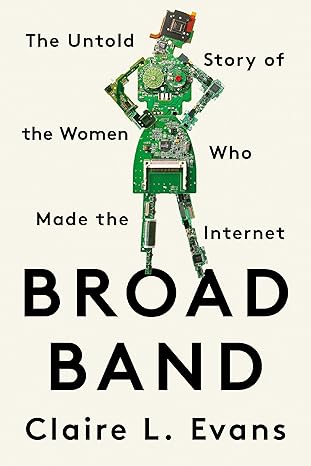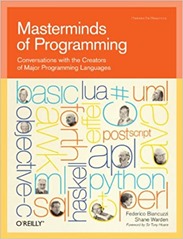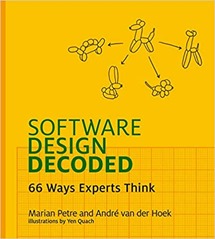After reading Broad Band by Claire L. Evans, about women in computing, I realised Grace Hopper was important, so I thought I’d hunt out a biography. I found Grace Hopper: Admiral of the Cyber Sea by Kathleen Broome Williams. Unusually I bought it second hand – my copy came from the Richard Stockton College of New Jersey Library Pomona, and has an austere, maroon cover.
Grace Hopper was born in New York City in 1906, she died in 1992. An undergraduate in mathematics she started a career in teaching at Vassar College but joined the Navy after the US joined the Second World War. She was posted to work on the Mark I computer at Harvard. She subsequently wrote the first software compiler, and was instrumental in the creation of the COBOL programming language. After “retiring” she then had a long career in the US Navy working on standardising their computing systems. After finally retiring from the Navy she worked for DEC for a few years until her death at the age of 86. She finished her career a rear admiral in the US Navy and has a battleship named for her (the USS Hopper) amongst numerous other rewards.
Grace Hopper gives some feel as to how it was to grow up in a relatively wealthy New York City family. The Hopper family had a holiday home in Wolfeboro, New Hampshire which, when she was small, was a day and a half travel to reach from New York City. She was brought up to be self-sufficient and trained in mathematics. Her father worked in insurance and was a double amputee – he wanted to make sure his children could fend for themselves should he die although he survived to a fair age.
Hopper studied mathematics first at Vasser College before going to Yale for a PhD in mathematics. She married Vincent Hopper in 1930, they bought a summer home of their own in Wolfeboro for $450 – part of a wedding gift. They were divorced in 1941 although it was not something she talked about, despite giving numerous interviews later in her live. Grace Hopper does not indicate the grounds for her divorce. After gaining her degree she became a lecturer in Vasser College where she was an excellent and committed teacher.
When America joined the war she was keen to serve in the US Navy which she achieved following some struggle. Fundamentally they were not keen to employ women, furthermore she was older than the Navy typically recruited, technically underweight and in a reserved occupation (as a lecturer in mathematics). Eventually she joined in 1942, and finally entered service in 1944, after training. She was proud to work in the Navy throughout her life and even whilst employed in industry she continued in the reserve service. In her Navy service she found a link with the dignitaries, including royalty, she met in later life.
Her naval placement was with the Mark I computer at Harvard, invented by Howard Aiken and built by IBM. It was the first programmable electromechanical computer in the world. Based on the slightly older relay technology rather than valves found in successors it was used principally for ballistic calculations as well as calculations of various function tables. Aiken was pretty tough to work with but Hopper clearly knew how to handle him and held him in high regard. She worked on many of the Mark I’s smaller programming jobs as well as doing more than her share of documentation and report writing.
One issue with the Mark I was that it was programmed with paper tape, the programs and data are stored as a pattern of holes 3-4mm across punched out the tape. There was a lot of paper around, as well as the disks of paper punched out from the tape. Sometimes one of the punched out disks was re-united with a hole causing an error, as Hopper pointed out “a hole getting back into a hole”!
After the war it was clear she would not be able to continue at Harvard, so she let to work on the UNIVAC at the Eckert–Mauchly Computer Corporation, later bought by the Rand Corporation and then IBM. Through Hopper’s life we see the birth and maturing of the new computing industry.
Hopper realised there was a need for standardisation in programming languages. There were an increasing number of different types of computer around, and the maintenance and programming of such computers was a bigger job than had initially been realised. Standardisation reduces this problem because a program written for one computer can be run on another. This is how COBOL was born, the Navy sponsored the Committee on Data Systems Languages (CODASYL) which created the COBOL programming language which was derived from Hopper’s FLOW-MATIC language developed for the UNIVAC.
As a scientist and software developer for 30 years I was scarcely aware of COBOL, yet it comprised approximately 80% of running code in the late nineties, according to Gartner. I imagine that figure has not dropped greatly. There is clearly a huge body of COBOL “dark matter” that software developers don’t talk about. The reason for COBOL’s obscurity seems to be the disdain of the academic computer science community, FORTRAN – born at the same time – suffers a similar disdain.
During her time working on UNIVAC Hopper maintained her Navy connection through a reserve position, and in 1966 – at the age of 60 – she retired from the reserve to work full time for the Navy at the Pentagon. She continued to work in the Navy until 1986 when she left to join DEC, at the age of 80!
In this book Grace Hopper comes out as an exceptional character. Her great skills were rooted in teaching, the drive to build a compiler was partly making her own life easier but also democratising the process of programming. She also saw the importance of raising a generation of programmers. She was very personable but seemed to have virtually no personal life. She drank moderately and smoked heavily for most of her life, and clearly had a bit of a hording problem towards the end. She was a life-long Republican and saw little value in the women’s rights movement – her own enormous success giving her the impression that there was no inequality to address.
Throughout her life, well into the period others might consider retiring, she was was engaged in a full schedule of public speaking. She gained many rewards, and a great deal of recognition in her lifetime.
I really enjoyed this book, the only place my interest lessened slightly was in the chapter describing administrative reorganisations of the US Navy. I am in awe of the achievements of Grace Hopper.





 Software Design Decoded: 66 Ways Experts Think
Software Design Decoded: 66 Ways Experts Think